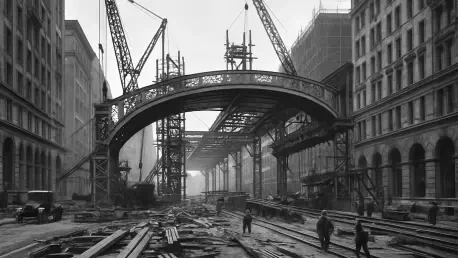As we dive into the world of urban infrastructure, I’m thrilled to sit down with Luca Calarailli, a seasoned expert in construction with a deep background in design and architecture. With a passion for integrating cutting-edge technology into large-scale projects, Luca brings a unique perspective on innovation in the industry. Today, we’ll explore his insights on a remarkable infrastructure achievement—the overhaul of the Park Avenue Viaduct in New York City. Our conversation touches on the challenges of modernizing historic structures, the strategies behind completing massive projects ahead of schedule and under budget, and the innovative tools that keep vital transit systems running during construction.
Can you walk us through your involvement in the Park Avenue Viaduct project and what made your team the right choice for such a significant undertaking?
Absolutely, Joshua. My team was brought on as the design-build contractor for this project with the Metropolitan Transportation Authority. Our role was to oversee the replacement of a critical piece of infrastructure—a 132-year-old viaduct carrying Metro-North trains through East Harlem. We got involved through a competitive procurement process where our ability to propose innovative construction techniques stood out. What made us a great fit was our experience with complex urban projects, a strong track record of collaboration with public agencies, and our focus on minimizing disruption to daily operations. We understood the stakes—keeping trains running while replacing 8,240 feet of track and 128 bridge sections was no small feat.
How did your team manage to complete the first phase of this project an astonishing 51 months ahead of schedule?
That was a proud moment for us. The key was in our early planning and willingness to push the boundaries of traditional construction timelines. We worked closely with the MTA to streamline processes, overlapping design and construction phases where possible. A major factor was our decision to use prefabricated bridge sections, which we could assemble off-site and install quickly during short weekend windows. This approach cut down on-site delays significantly. Constant communication with the MTA ensured we stayed aligned, and we were able to address potential bottlenecks before they became issues. It was a team effort, with everyone focused on the same goal.
Coming in $93 million under budget is no small achievement. What strategies helped you save costs without compromising quality?
Cost savings came down to efficiency and smart decision-making from the start. By proposing our own construction methods during the design-build phase, we avoided more expensive, time-intensive approaches like long-term service shutdowns. Prefabrication played a big role here too—it reduced labor costs and minimized errors on-site. We also optimized material usage and coordinated closely with suppliers to avoid waste. But let me be clear: we never cut corners. Quality was non-negotiable, especially for a structure this critical. Every decision was weighed against safety and durability standards to ensure the viaduct would serve commuters for decades to come.
Can you explain the custom-built gantry system your team used and why it was so essential for this project?
The gantry system was a game-changer. We designed it specifically to span Park Avenue, allowing us to lift out old, deteriorated steel and concrete deck segments and install new prefabricated bridge sections—all without shutting down Metro-North service. It was essential because the viaduct carries 98% of the railroad’s daily trains, and long disruptions just weren’t an option. This system let us work on one side of the structure while trains kept running on the other. It’s a technique we’ve adapted from past projects, but we tailored it heavily for the unique constraints of this site, like the tight urban environment and the weight of the 190,000-pound sections we were hoisting.
What were some of the biggest hurdles in replacing such an extensive stretch of track and bridge sections on a historic elevated structure?
Working on a 132-year-old viaduct presented unique challenges. The age of the structure meant we had to be incredibly careful during demolition—there were unknowns about how the existing materials would behave under stress. We conducted detailed assessments beforehand to map out weak points. Another hurdle was the sheer scale: swapping out 8,240 feet of track over 128 installations required precision and coordination, especially in a dense area like East Harlem. We did hit some unexpected issues, like discovering hidden deterioration in some segments, but our team adapted quickly with on-the-fly engineering solutions to keep moving forward.
How did you ensure safety for both your workers and the commuters while keeping Metro-North trains operational during construction?
Safety was our top priority. Hoisting 190,000-pound bridge sections over a busy avenue like Park Avenue meant we had to have ironclad protocols in place. We used protective barriers and strict scheduling to ensure no work happened during peak train or pedestrian times. For workers, we implemented rigorous training and safety checks on all equipment, especially the gantry system. To keep trains running, we carefully timed our track connections and system integrations during overnight or weekend windows, testing everything before service resumed. It was a delicate balance, but constant monitoring and clear communication with the MTA made it possible.
Looking ahead, what is your forecast for the future of urban transit infrastructure projects, especially when it comes to balancing modernization with minimal disruption?
I’m optimistic about where we’re headed. Urban transit projects are increasingly leaning on technology and innovative construction methods to tackle the dual challenge of upgrading aging infrastructure while keeping cities moving. I think we’ll see more use of modular construction and digital tools like Building Information Modeling to plan and execute with precision. The focus will be on sustainability too—using materials and methods that last longer and reduce environmental impact. But the real game-changer will be collaboration between contractors, agencies, and communities to prioritize rider experience. Projects like the Park Avenue Viaduct show that it’s possible to modernize without major disruption, and I believe that will become the standard in the years ahead.









